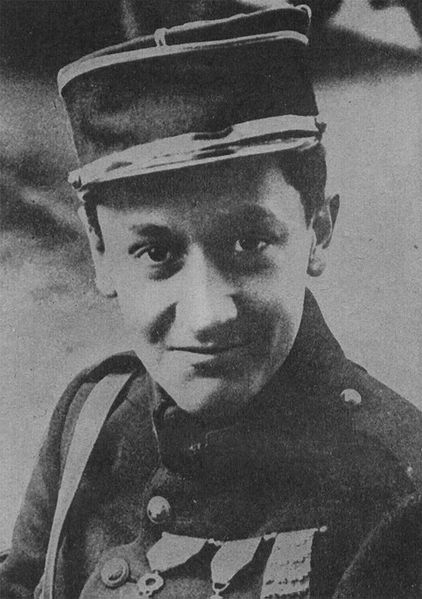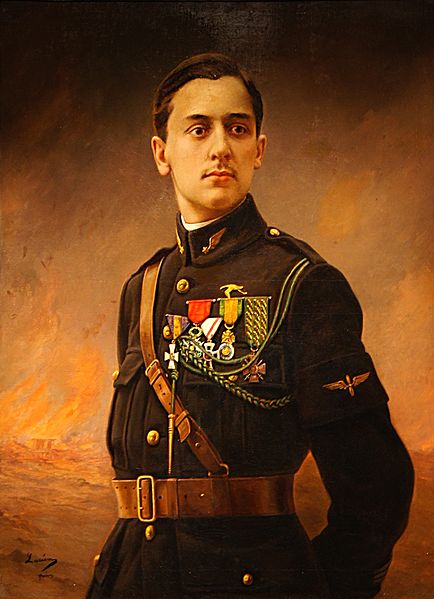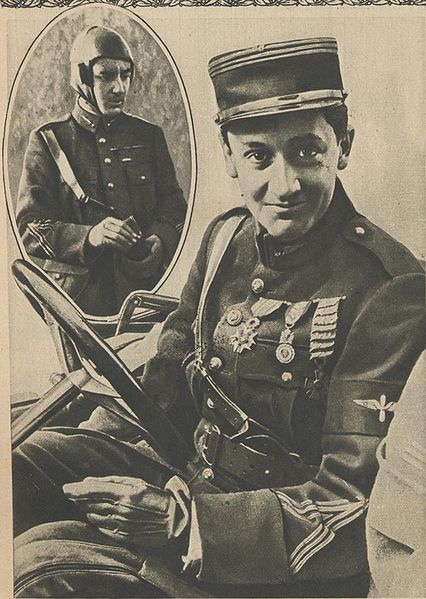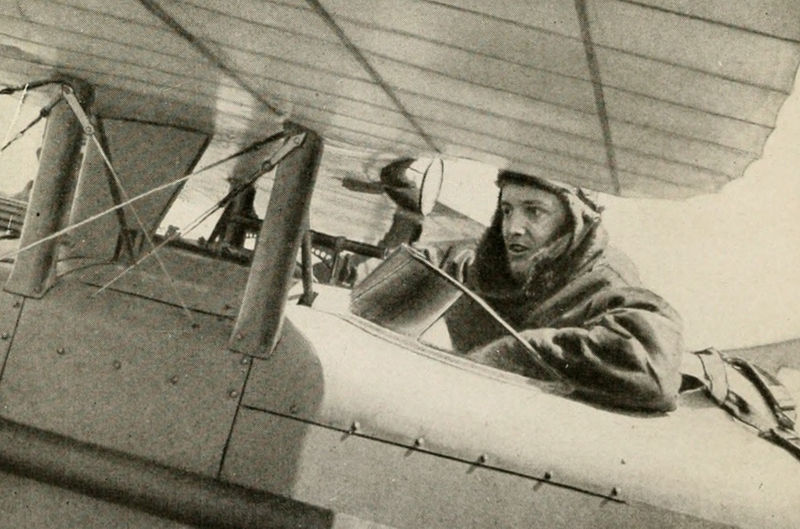<Back to Index>
- Astronomer Jean Louis Pons, 1761
- Poet Juan Ramón Jiménez Mantecón, 1881
- Flying Ace Georges Guynemer, 1894
PAGE SPONSOR


Georges Guynemer (24 December 1894 - 11 September 1917 missing) was a top fighter ace for France during World War I, and a French national hero at the time of his death.
Georges Marie Ludovic Jules Guynemer was born to a wealthy Compiègne family and experienced an often sickly childhood. Nevertheless, he succeeded as an aviator through his enormous drive and self - confidence.
He was originally rejected for military service, but was accepted for training as a mechanic in late 1914. With determination, he gained acceptance to pilot training, joining Escadrille MS.3 on 8 June 1915. He remained in the same unit for his entire service. He experienced both victory and defeat in the first plane allocated to him, a Morane - Saulnier L monoplane previously flown by Charles Bonnard, and accordingly named Vieux Charles (Old Charles). Guynemer kept the name and continued to use it for most of his later aircraft.
On 5 December 1915, the Escadrille MS.3 was renamed the Escadrille N.3, after being re-equipped with new Nieuport 10 fighters. Flying the more effective plane, Guynemer quickly established himself as one of France's premier fighter pilots. He became an ace by his fifth victory in February 1916, and was promoted to lieutenant in March. At the year's end, his score had risen to 25. Capitaine Brocard, commander of Escadrille N.3 (Storks), described Guynemer at that time as "...my most brilliant Stork." Less than a year later, Guynemer was promoted to captain and commander of the Storks squadron.
Guynemer
became influential enough to affect French fighter aircraft design; in
December 1916, he wrote a letter to the chief designer at Spad criticizing the Spad VII as inferior to the German Halberstadt that was its contemporary. As a consequence, Spad developed two new but very similar models, the SPAD XII and SPAD XIII. The new models were promising, but had teething problems with the reduction gear between engine and propeller. On 8 February 1917, flying a SPAD VII, Guynemer became the first Allied pilot to shoot down a German heavy bomber (Gotha G.III). His greatest month was May 1917, when he downed seven German aircraft. By July, he began to fly the Spad XII; his avion magique was,
at his behest, armed with a 37 mm (1.46 in) cannon whose
barrel fired through the propeller shaft. It was also armed with a
.30 in (7.62 mm) machine gun. Although the cannon promised
devastating firepower, the new plane was a handful because of it. The
single shot cannon had to be manually reloaded in flight; it had a
heavy recoil when fired, and filled the canopy with fumes from every
shot. The Spad XII was not a plane for a novice pilot. However,
Guynemer used it to down an Albatros fighter on 27 July, and a DFW the next day. The latter triumph made him the first French ace to attain 50 victories. Guynemer
failed to return from a combat mission on 11 September 1917. The
previous week had been one of mechanical ills, in both his assigned
aircraft and the ones he borrowed. At 08:30, with rookie pilot Jean Bozon - Verduraz, Guynemer took off in his Spad XIII S.504 n°2. His mission was to patrol the Langemark area. At 09:25, near Poelkapelle, Guynemer sighted a lone Rumpler,
a German observation plane, and dived toward it. Bozon - Verduraz saw
several Fokkers above him, and by the time he had shaken them off, his
leader was nowhere in sight, so he returned alone. Guynemer never came
back. Neither
the wreckage of his airplane, his body, nor his personal effects were
ever found, but the Germans announced that he had been shot down by Lt. Kurt Wissemann of Jasta 3,
who in turn was killed in action 17 days later. French schoolchildren
of the time were taught that Guynemer had flown so high, he couldn't
come back down again. At the time of his death, he had tallied 53
victories. In all, he survived being shot down seven times, despite not
having a parachute.
It is not clear if he was killed in the crash of his plane or if he
survived, only to be shot on the ground in no-man's land. Some
speculate that his aircraft may have been blown apart by artillery shells. Captain
Georges Guynemer was confirmed missing in action by his squadron
commander Major Brocard; it was officially announced in Paris by the
French War Department on 25 September 1917. Unofficial confirmation came from a captured German pilot who was shot down behind Canadian lines the evening of 29 September. A
German sergeant from the 413th Regiment swore he had witnessed the
crash and identified Guynemer's corpse; he also certified that the
French hero had died from a bullet through the head, with other
injuries including a broken leg and a finger shot away. The German
party retrieving the body was driven away by Allied artillery fire
before they could bury or remove the body. The
25 September details released by the French War Department were
unclassified and became public knowledge as described by one of his
flying comrades (name withheld due to security reasons): Guynemer
sighted five machines of the Albatros type D-3. Without hesitation, he
bore down on them. At that moment enemy patrolling machines, soaring at
a great height, appeared suddenly and fell upon Guynemer. There were
forty enemy machines in the air at this time, including Count von
Richtofen and his circus division of machines, painted in diagonal blue
and white stripes. Toward Guynemer's right some Belgian machines hove
in sight, but it was too late. Guynemer must have been hit. His machine
dropped gently toward the earth, and I lost track of it. All that I can
say is that the machine was not on fire. Additional details were furnished by Major Brocard, as listed in an article from the Paris Le Matin: The
last fight of the French aviator occurred four or five miles inside the
German lines northeast of Ypres and opposite the British lines. Captain
Guynemer was accompanied by Lieutenant Bozon Verduraz, who says that
they were flying at a height of 15,000 feet when Guynemer sighted
an an enemy two - seater, which he attacked. Almost at the same moment
Verduraz saw four German monoplanes approaching and turned toward them
instantly so as to draw them off. They circled around for a while and
then disappeared. Verduraz then returned to the place where he had left
Guynemer engaged with the German biplane, but Guynemer had vanished. According
to an American Red Cross communique from the French front, the death of
Captain Georges Guynemer was determined to be "definitely confirmed". This Red Cross report provided these details: Information
received by the Red Cross says Guynemer was shot through the head north
of Poelcapelle, on the Ypres front. His body was identified by a
photograph on his pilot's license found in his pocket. The burial took
place at Brussels in the presence of a guard of honor, composed of the
5th Prussian Division. Such is the story told by a Belgian, who has
just escaped from the Germans. The burial was about to take place at
Poelcapelle, when the bombardment preceding the British attack at Ypres
started. The burying party hastily withdrew, taking the body with them.
The German General chanced to be an aviation enthusiast with a great
admiration for Captain Guynemer's achievements. At his direction the
body was taken to Brussels in a special funeral car. Thither the
captain was carried by non-commissioned officers and was covered with
floral tributes from German aviators. The Prussian Guards stood at
salute upon its arrival and during the burial, which was given all
possible military honors. The French Government has been invited to
place in the Pantheon, where many great Frenchmen are buried, an
inscription to perpetuate the memory of Captain Guynemer as ′a symbol
of the aspirations and enthusiasm of the Army.′ A resolution to this
effect has been introduced in the Chamber of Deputies by Deputy Lasies. Guynemer was lionized by the French press and became a national hero. The French government encouraged
the publicity to boost morale and take the people's minds off the
terrible losses in the trenches. Guynemer was embarrassed by the
attention, but his shyness only increased the public's appetite to know
everything about him. This was quite different later in 1918 with the
French top ace René Fonck,
who despite having 75 confirmed victories, had bad publicity for his
arrogance and shameless self - promotion. Guynemer's death was a profound
shock to France; nevertheless, he remained an icon for the duration of
the war. Only 22 at his death, he continued to inspire the nation with
his advice, "Until one has given all, one has given nothing."

